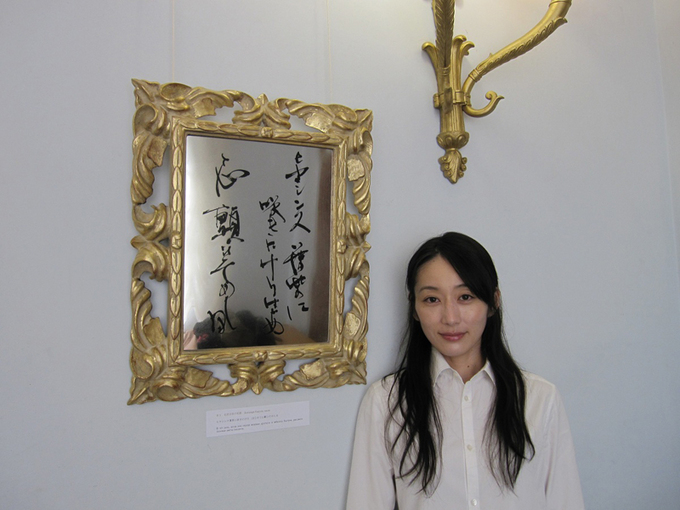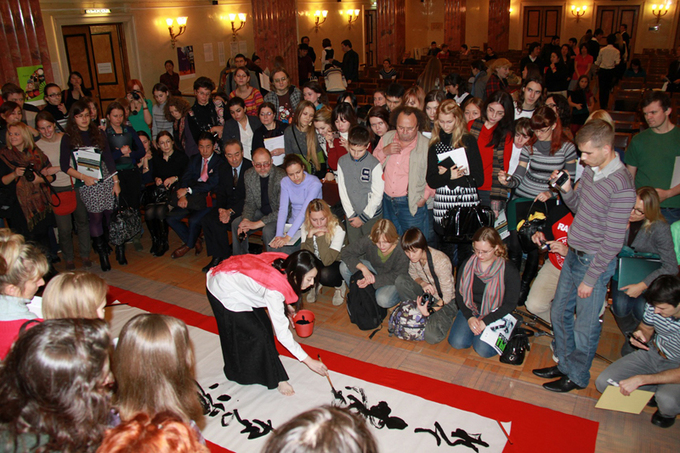Introducing the Beauty of Japanese Characters--A Calligrapher on Tour in Ukraine, Kazakhstan, and Russia--
Japanese-Language Course Section
(Japanese-Language) Teachers and Institutional Support Dept.
In this day and age of personal computers and mobile phones, opportunities to write by hand are quickly diminishing. When it comes to shodo (Japanese calligraphy), it is likely that most Japanese adults have not held a fude brush in years, perhaps since primary school or a kakizome event (the first shodo written at the beginning of the year). Surprisingly, however, in some far-away countries in Eastern Europe and Central Asia, you can find people who are actually taking up brushes and writing in Japanese.
Mariko Kinoshita is a calligrapher who is promoting shodo around the world through her Beautiful Japanese Letters project. Her aim is to create an opportunity for people in other countries to appreciate the beauty of Japanese letters, words, and literature, and more importantly, to understand the Japanese values and aesthetics inherent in them. With this goal in mind, Ms. Kinoshita set out in October on a three-country, four-city tour.
Her destinations were Kiev, Astana, Almaty, and Moscow. These cities occasionally see their first snow as early as late October, so Ms. Kinoshita packed her suitcase with a down coat, heating pads and other winter items, and flew off from Japan, where it was still warm enough to get by with a light jacket.
Calligraphy in the mirror
The first stop of the tour was the Ukraine-Japan Center located in Kiev, the Ukrainian capital. In addition to the shodo demonstration and workshops, Ms. Kinoshita organized an exhibition of works that she had prepared specifically for this event. When we think back to the shodo lessons of primary school, we remember using a brush, ink, and sheets of paper, but Ms. Kinoshita's work is written on mirrors: when you look at the work, what you see is your own reflection.
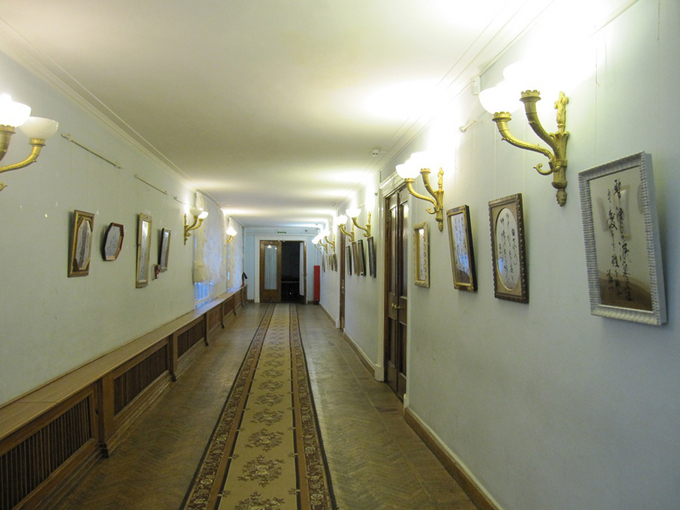
Exhibition in Russian State Library
These works were made using a highly volatile, special type of deep ink, and they are written not on a piece of writing paper but on material called mirror sheets. The frames were made by Fuga Gakushi, a picture frame craftsman who works from a studio in Matsuyama, Ehime Prefecture. The art deco frames perfectly matched the calligraphy, creating a superb blend of East and West.
On display were a total of 18 works, all of which were calligraphy of the verses created by poets of the Taisho period (1912-1926), such as Akiko Yosano. The world of shodo is profound, requiring the practitioner to consider a host of factors including the spatial balance of the characters, the positioning of the kanji in relation to hiragana, and so on.
Hiragana is believed to have been developed by women of the Heian period (794-1192) as an alternative writing system, because in those days only men were permitted to use the kanji that had been imported from China. Expressing the various scenes, sounds, and fragrance of each season in the shape of each letter, the Japanese developed hiragana into a writing system marked by elegance and grace. These letters have reflected Japan's cultural aesthetics through its long history. In Ms. Kinoshita's work, it is these beautiful letters that are written on the mirrors. The purpose of the mirror is to enable you to re-connect with your inner soul by facing your reflection, which is at the same time the surface of the work. The work is literally a mirror that reflects your emotional, spiritual state. What do you see in there--the past, the present, or the future?
Experiencing the popularity of the Japanese language
In Moscow, Ms. Kinoshita's shodo demonstration and workshops were organized as a special program during the 24th International Student Japanese Language Speech Contest that took place in the Russian State Library. The competition is held around this time every year in Moscow. The contestants are the students from the CIS countries who have won the preliminary rounds in their respective home countries. One such student was Ms. Oliga, who also attended an earlier workshop in Kiev, the tour's first stop. As we prepared for the demonstration backstage, we could hear the contestants presenting their speeches. They were so fluent that, if you didn't see their faces, you would think you were listening to native Japanese speakers. The speeches were deeply interesting, and conveyed the speakers' keen interest in Japanese.
Once the three-and-a-half hour long speech contest was over, it was time for Ms. Kinoshita's special program. The hall was packed with over 100 visitors, a higher attendance than previously expected. Everyone stood around the two sheets of paper, each 97×180cm in size, which were placed side-by-side on the floor. People in the back could not see Ms. Kinoshita's demonstration even if they stood on tiptoe, so they mounted the stage, which soon filled up.
In time to an early 20th century Japanese song, Kojo No Tsuki (The Moon Over the Ruined Castle), Ms. Kinoshita wrote a short passage from the novel by Ogai Mori, Maihime (The Dancing Girl): "After a momentary pause, the tears welled up in her eyes again and rolled down her lovely cheeks." A breath-taking tension filled the room. This was the moment when Ms. Kinoshita's brush would bring the classic masterpiece to life. When she completed her last stroke just as the last notes of the music played, there was thunderous applause and the room lit up with camera flashes.
A shodo workshop followed the demonstration. There were no desks in the room to work on, so the participants used a fude-pen, or a brush-like pen, in order not to stain their clothes. The 100 calligraphy sets we had prepared for the event were quickly gone. The participants were going to write the kanji "sakura" (cherry blossom) and the text "Jin wa ai wo shu to su," which is a quote about love and benevolence from Shoin Yoshida, a mid-19th century scholar and philosopher. First Ms. Kinoshita talked about the Japanese values and aesthetics symbolized by the cherry blossom while showing beautiful pictures of the cherry trees in bloom. All eyes were on Ms. Kinoshita as the audience listened intently. Their faces were serious. Afterwards, they wrote their calligraphy on pieces of colored paper. When the workshop was over, many participants lined up to ask questions.
We spoke to Ms. Oliga, who attended the workshops in Moscow as well as in Kiev. With the speech contest over, she now appeared relaxed. "I saw Mariko Kinoshita's shodo for the first time in Kiev," she said, "Her works struck me as both mystical and soothing, and I was captivated by the mirrors adorned with her calligraphy." She continued: "I read each of the poems written on the mirrors and felt many different emotions - tenderness, warmth, and sadness. They left a strong impression on me. It was truly a pleasure to have such a wonderful experience."
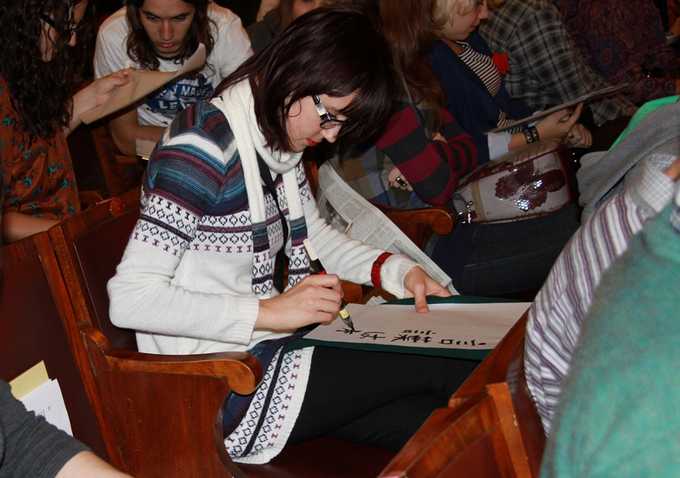
Ms. Oliga attended the workshops both in Kiev and Moscow
The Japan Foundation offers Japanese language courses in our overseas offices and the Japan Centers located around the world. The number of Japanese language learners has grown enormously over the past 20 years, and their reasons for studying Japanese have become much more diverse, with an interest in manga or anime being among the relatively new motivations. Under such circumstances, the Japan Foundation has been striving to cater effectively to the learners' needs and to promote Japanese as a tool to encourage mutual understanding between the people of Japan and other countries, which is the principle and goal of the JF Standard for Japanese-Language Education. In order to foster greater interest in and understanding of Japan, we will continue to offer helpful learning opportunities and host a variety of events, like the shodo workshop described here, to provide first-hand experience of Japanese culture.
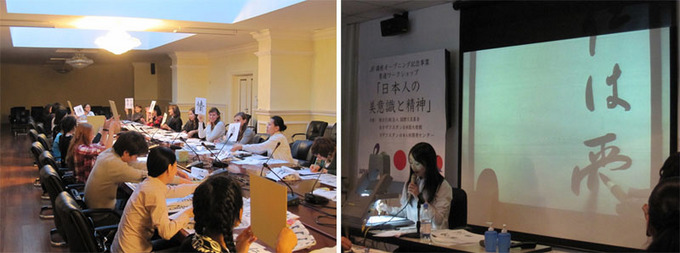
Left: Workshop in Astana
Right: Workshop in Almaty
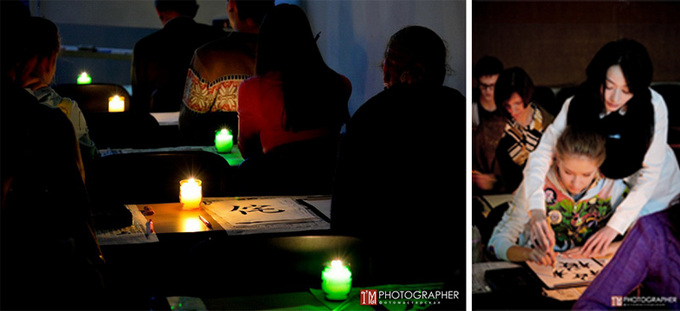
Left: During the workshop in Kiev, the lights were turned off
Right: The participants worked on their shodo in a candle-lit room
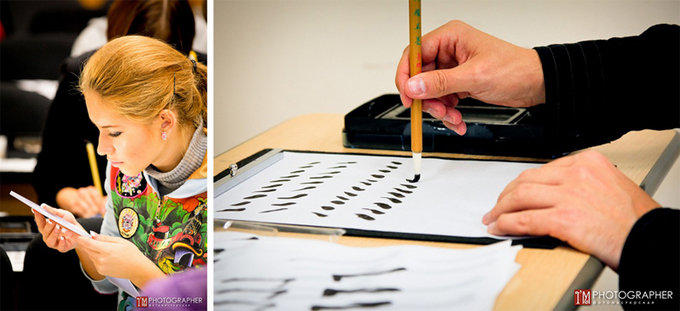
Left: One participant observes her completed work written on a hand-mirror
Right: A participant fills the page with practice strokes
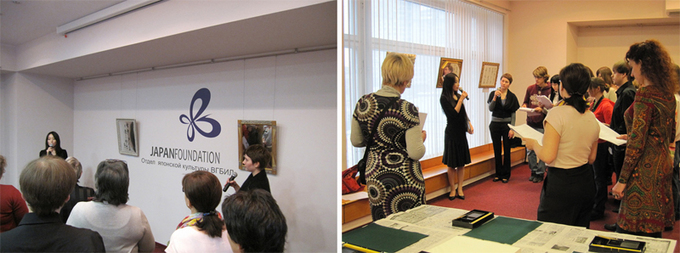
Left: A workshop was also held at the Japanese Culture Department "Japan Foundation" of the All-Russia State Library for Foreign Literature office using Ms. Kinoshita's texts
Right: Ms. Kinoshita lecturing about the Taisho period Japanese culture
Keywords
- Traditional Arts
- Literature
- Language
- Japanese Studies
- Japanese-Language Education
- JF Worldwide
- Cultural Policy/Public Diplomacy
- Kazakhstan
- Ukraine
- Russia
- Shodo
- Eastern Europe
- Central Asia
- Mariko Kinoshita
- Kiev
- Astana
- Almaty
- Moscow
- Fuga Gakushi
- Akiko Yosano
- Russian State Library
- Shodo demontration
- Kojo No Tsuki
- Ogai Mori
- Japan Centers
Back Issues
- 2024.3. 4 Movie Theaters aroun…
- 2023.4.10 The 49th Japan Found…
- 2023.3.28 JF's Initiatives for…
- 2023.1.27 Living Together with…
- 2022.11.16 Inner Diversity <…
- 2022.6.21 The 48th Japan Found…
- 2022.3.22 JF's Initiatives for…
- 2022.3.14 JF's Initiatives for…
- 2022.2.14 JF's Initiatives for…
- 2022.2. 4 JF's Initiatives for…


